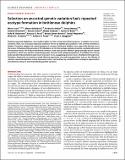Files in this item
Selection on ancestral genetic variation fuels repeated ecotype formation in bottlenose dolphins
Item metadata
| dc.contributor.author | Louis, Marie | |
| dc.contributor.author | Galimberti, Marco | |
| dc.contributor.author | Archer, Frederick | |
| dc.contributor.author | Berrow, Simon | |
| dc.contributor.author | Brownlow, Andrew | |
| dc.contributor.author | Fallon, Ramon | |
| dc.contributor.author | Nykänen, Milaja | |
| dc.contributor.author | O'Brien, Joanne | |
| dc.contributor.author | Robertson, Kelly | |
| dc.contributor.author | Rosel, Patricia E. | |
| dc.contributor.author | Simon-Bouhet, Benoit | |
| dc.contributor.author | Wegmann, Daniel | |
| dc.contributor.author | Fontaine, Michael | |
| dc.contributor.author | Foote, Andrew | |
| dc.contributor.author | Gaggiotti, Oscar Eduardo | |
| dc.date.accessioned | 2021-10-28T15:30:13Z | |
| dc.date.available | 2021-10-28T15:30:13Z | |
| dc.date.issued | 2021-10 | |
| dc.identifier | 275759718 | |
| dc.identifier | bc0dd952-6772-4582-851a-d1c597d0c135 | |
| dc.identifier | 85118314759 | |
| dc.identifier | 000711847100003 | |
| dc.identifier.citation | Louis , M , Galimberti , M , Archer , F , Berrow , S , Brownlow , A , Fallon , R , Nykänen , M , O'Brien , J , Robertson , K , Rosel , P E , Simon-Bouhet , B , Wegmann , D , Fontaine , M , Foote , A & Gaggiotti , O E 2021 , ' Selection on ancestral genetic variation fuels repeated ecotype formation in bottlenose dolphins ' , Science Advances , vol. 7 , no. 44 , abg1245 . https://doi.org/10.1126/sciadv.abg1245 | en |
| dc.identifier.issn | 2375-2548 | |
| dc.identifier.other | ORCID: /0000-0003-1827-1493/work/102330533 | |
| dc.identifier.uri | https://hdl.handle.net/10023/24215 | |
| dc.description | Funding: Marine Research from the American Museum of Natural History; People’s Trust for Endangered Species; European Society for Evolutionary Biology (ESEB), GRANT #(s) Godfrey Hewitt mobility award; Fyssen Foundation; The Russell Trust; Total Foundation, FUNDREF 10.13039/501100018758; University of Groningen, FUNDREF 10.13039/501100001721; Swiss National Science Foundation, FUNDREF 10.13039/501100001711, GRANT #(s) 31003A_173062; University of St Andrews, FUNDREF 10.13039/501100000740; Marine Alliance for Science and Technology for Scotland, FUNDREF 10.13039/100015535. | en |
| dc.description.abstract | Studying repeated adaptation can provide insights into the mechanisms allowing species to adapt to novel environments. Here, we investigate repeated evolution driven by habitat specialization in the common bottlenose dolphin. Parapatric pelagic and coastal ecotypes of common bottlenose dolphins have repeatedly formed across the oceans. Analyzing whole genomes of 57 individuals, we find that ecotype evolution involved a complex reticulated evolutionary history. We find parallel linked selection acted upon ancient alleles in geographically distant coastal populations, which were present as standing genetic variation in the pelagic populations. Candidate loci evolving under parallel linked selection were found in ancient tracts, suggesting recurrent bouts of selection through time. Therefore, despite the constraints of small effective population size and long generation time on the efficacy of selection, repeated adaptation in long-lived social species can be driven by a combination of ecological opportunities and selection acting on ancestral standing genetic variation. | |
| dc.format.extent | 13 | |
| dc.format.extent | 2264482 | |
| dc.language.iso | eng | |
| dc.relation.ispartof | Science Advances | en |
| dc.subject | GC Oceanography | en |
| dc.subject | QH301 Biology | en |
| dc.subject | QH426 Genetics | en |
| dc.subject | DAS | en |
| dc.subject.lcc | GC | en |
| dc.subject.lcc | QH301 | en |
| dc.subject.lcc | QH426 | en |
| dc.title | Selection on ancestral genetic variation fuels repeated ecotype formation in bottlenose dolphins | en |
| dc.type | Journal article | en |
| dc.contributor.institution | University of St Andrews. Scottish Oceans Institute | en |
| dc.contributor.institution | University of St Andrews. Marine Alliance for Science & Technology Scotland | en |
| dc.contributor.institution | University of St Andrews. School of Biology | en |
| dc.contributor.institution | University of St Andrews. St Andrews Bioinformatics Unit | en |
| dc.identifier.doi | 10.1126/sciadv.abg1245 | |
| dc.description.status | Peer reviewed | en |
This item appears in the following Collection(s)
Items in the St Andrews Research Repository are protected by copyright, with all rights reserved, unless otherwise indicated.

